Laboratory for New Formulation Technology of Chinese Medicinal Preparations BÜCHI Mini Spray Dryer B-290 Spray Dryer |
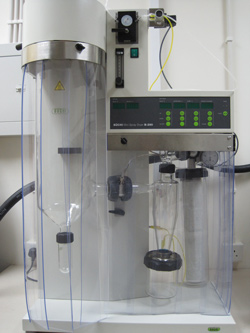 Introduction: lMaximum drying capacity: 1 L water/hour lDrying duration: 1.0 – 1.5 seconds lMaximum air flow rate: 35 m3/hour lMaximum drying temperature: 220 oC lLED digital display at inlet temperature, outlet humidity, ventilator wind speed, peristaltic pump flow rate. lWith inert gas accessory B295 for spray drying organic solvent. lAutomatic online nozzle cleaning. lMinimal sample volume: 20-50 ml |
Laboratory for New Formulation Technology of Chinese Medicinal Preparations Extrusion/Spheronization Multi-purpose extrusion, spheronization, coating system |
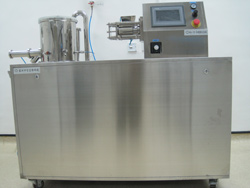 Introduction: lEquipped with extrusion/spheronization, drying and coating functions. Useful for the preparation of pellets by extrusion-spheronization, together with spray coating for the manufacture of protective coating, enteric coating or delay-release coating and drug delivery. lUnique temperature control system. lPore plate with different size for the preparation of 0.1 – 0.3 mm small pellet. lPrecise control in coating temperature. Good quality in atomizer. Reliable quality in coating. Modular structure for easy cleaning and GMP compliance. |
Laboratory for New Formulation Technology of Chinese Medicinal Preparations Mini Glatt Fluid Bed Processor |
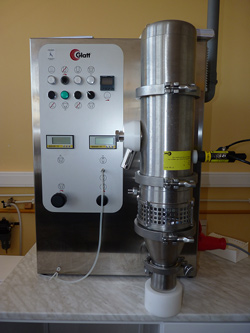 Introduction: lFor drying, pelletization and coating in small laboratory scale. lDual atomizer nozzle for pelletization and coating. lMinimal processing amount at 2.5 – 10 grams with Micro-Kit |
Laboratory for New Formulation Technology of Chinese Medicinal Preparations Microfluidics M-110P High Pressure Microfluidizer |
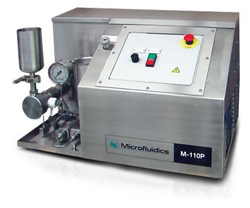 Introduction lFor the small scale preparation of nano-crystal and liposome. lMaximal working pressure at 30,000 psi; normal flow rate at 110 – 155 ml/min; smallest fluidic volume at 25 ml. lThe contact surface for the fluid is corrosive-resistance 316 stainless steel and other specialized material. lEquipped with hydraulic pump. Manual control of pressure and valve. Automatic control of oil hydraulic pump. |
Laboratory for New Formulation Technology of Chinese Medicinal Preparations APV-2000 Homogeniser |
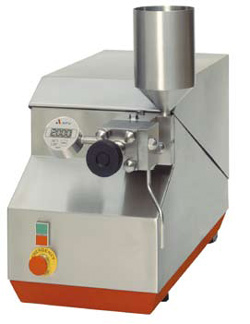 Introduction lFor crushing solid pellet into extremely small pieces, and the preparation of reproducible nano-scale dispersion solution. lFor the preparation of nano-scale emulsion and liposome. lMaximal operating pressure at 2,000 bars with minimal volume at 50 ml. |
Laboratory for New Formulation Technology of Chinese Medicinal Preparations
Malvern Zetasizer NanoZS90 |
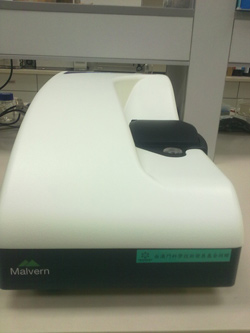 lMeasurement of particle size Zeta potential in dispersion solution from 0.3 nm to 5 m. lZeta potential measurement from 3.8 nm to 100 m. lParticulate concentration range from 0.1 ppm (0.00001 v/v %) – 40 wt%. |
Laboratory for New Formulation Technology of Chinese Medicinal Preparations ERWEKA Dissolution Tester Offline System |
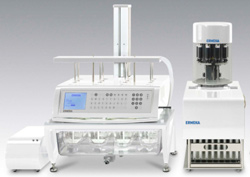 Introduction lAutomated sampling system for replenishment of withdrawn media lUnique design to prevent evaporation and contamination from withdrawn media lAutomated adjustment of dissolution container lAutomated dosing arm for testing of sample at the preset temperature |
Laboratory for New Formulation Technology of Chinese Medicinal Preparations Pharma-test Automated PTG S3 Powder Testing System |
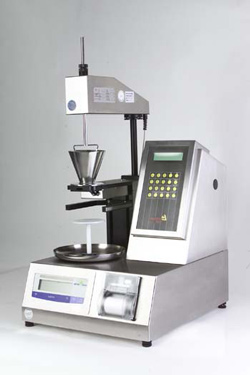 Introduction lDetermination of sample powder flow time, powder volume, density, angle of repose, fluidity of 100 mg samples, total sample weight in a defined time window, and sample flow chart in mg/time lAngle of repose from 1.0o to 45.0o lFluidity test range from 0.1 s to 999 s for 100 grams sample lPowder density from 0.000 g/ml to 6.0 g/ml lPowder weight from 1 mg to 325 g lPowder volume from 0.1 ml to 275 ml |
Laboratory for New Formulation Technology of Chinese Medicinal Preparations ERWEKA USP 4 Close-loop Dissolution Tester Offline System |
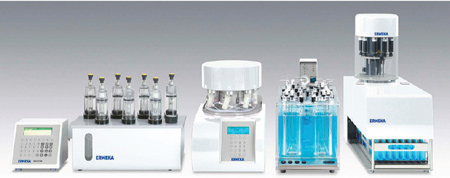 Introduction:
|

- Home
- Introduction to the State Key Laboratory
-
Framework of the Laboratories
- Laboratory for Quality Assessment and Control of Chinese Medicines
- Laboratory for Bioorganic and Chinese Materia Medica Chemistry
- Laboratory for Bioassay and Molecular Pharmacology of Chinese Medicines
- Laboratory for New Formulation Technology of Chinese Medicinal preparations
- Center for Omics Technology and Innovative Drug Research
- Macau Center For MS and NMR Analysis
- Center for Safety and Quality Assurance of Chinese Medicines and Foods
- Laboratory of Structural Biology and AI-based Drug Design
- Laboratory of Animal Models in Translational Medicine
- Laboratory of Ion Channel Biophysics and Innovative Drug Discovery
- Dr. Neher's Biophysics Laboratory for Innovative Drug Discovery
- Macau Centre for International Standard of Chinese Medicines
- Academic Research Team
- Research Accomplishments
-
Ongoing Research Projects
- FDCT Funding Scheme for Scientific Research and Innovation
- FDCT Funding Scheme for Innovation and Technology Promotion
- Macao Funding Scheme for Key R&D Projects
- FDCT Projects
- FDCT and NSFC Joint Scientific Research Project Funding Scheme
- FDCT and MOST Joint Scientific Research Project Funding Scheme
- FDCT and GDST Joint Scientific Research Project Funding Scheme
- FDCT Corporate Innovation R&D Funding Program
- Faculty Research Grant Projects
- Education and Training
- Collaboration and Opening
- Advanced equipment
- R & D of Products and High-technology Consultancy Services
- Newly Events and Highlights
- Contact Us

- Home
- Introduction to the State Key Laboratory
-
Framework of the Laboratories
- Laboratory for Quality Assessment and Control of Chinese Medicines
- Laboratory for Bioorganic and Chinese Materia Medica Chemistry
- Laboratory for Bioassay and Molecular Pharmacology of Chinese Medicines
- Laboratory for New Formulation Technology of Chinese Medicinal preparations
- Center for Omics Technology and Innovative Drug Research
- Macau Center For MS and NMR Analysis
- Center for Safety and Quality Assurance of Chinese Medicines and Foods
- Laboratory of Structural Biology and AI-based Drug Design
- Laboratory of Animal Models in Translational Medicine
- Laboratory of Ion Channel Biophysics and Innovative Drug Discovery
- Dr. Neher's Biophysics Laboratory for Innovative Drug Discovery
- Macau Centre for International Standard of Chinese Medicines
- Academic Research Team
- Research Accomplishments
-
Ongoing Research Projects
- FDCT Funding Scheme for Scientific Research and Innovation
- FDCT Funding Scheme for Innovation and Technology Promotion
- Macao Funding Scheme for Key R&D Projects
- FDCT Projects
- FDCT and NSFC Joint Scientific Research Project Funding Scheme
- FDCT and MOST Joint Scientific Research Project Funding Scheme
- FDCT and GDST Joint Scientific Research Project Funding Scheme
- FDCT Corporate Innovation R&D Funding Program
- Faculty Research Grant Projects
- Education and Training
- Collaboration and Opening
- Advanced equipment
- R & D of Products and High-technology Consultancy Services
- Newly Events and Highlights
- Contact Us

- All
- Introduction to the State Key Laboratory
- Contact Us
- Framework of the Laboratories
- Research Accomplishments
- Ongoing Research Projects
- Education and Training
- Collaboration and Opening
- Advanced equipment
- R & D of Products and High-technology Consultancy Services
- Newly Events and Highlights
- Academic Research Team
- Recruitment Information
-
-
Laboratory for Quality Assessment and Control of Chinese Medicines
-
Laboratory for Bioorganic and Chinese Materia Medica Chemistry
-
Laboratory for Bioassay and Molecular Pharmacology of Chinese Medicines
-
Laboratory for New Formulation Technology of Chinese Medicinal preparations
-
Center for Safety and Quality Assurance of Chinese Medicines and Foods
-
Laboratory of Ion Channel Biophysics and Innovative Drug Discovery
-
Dr. Neher's Biophysics Laboratory for Innovative Drug Discovery
-
Macau Centre for International Standard of Chinese Medicines
-




